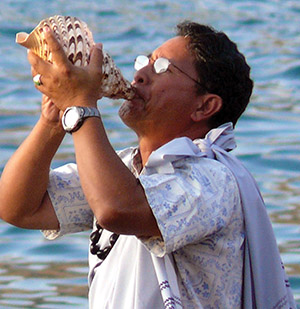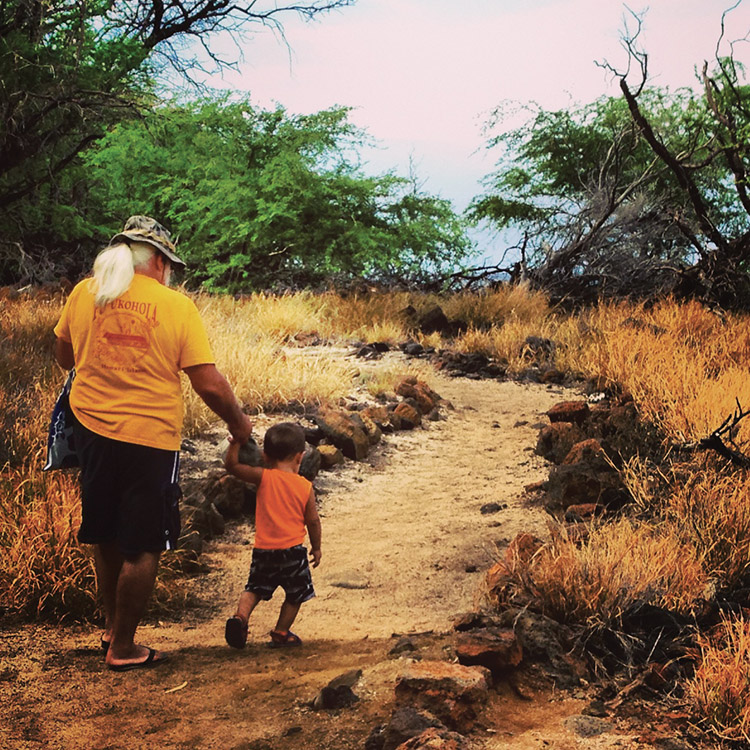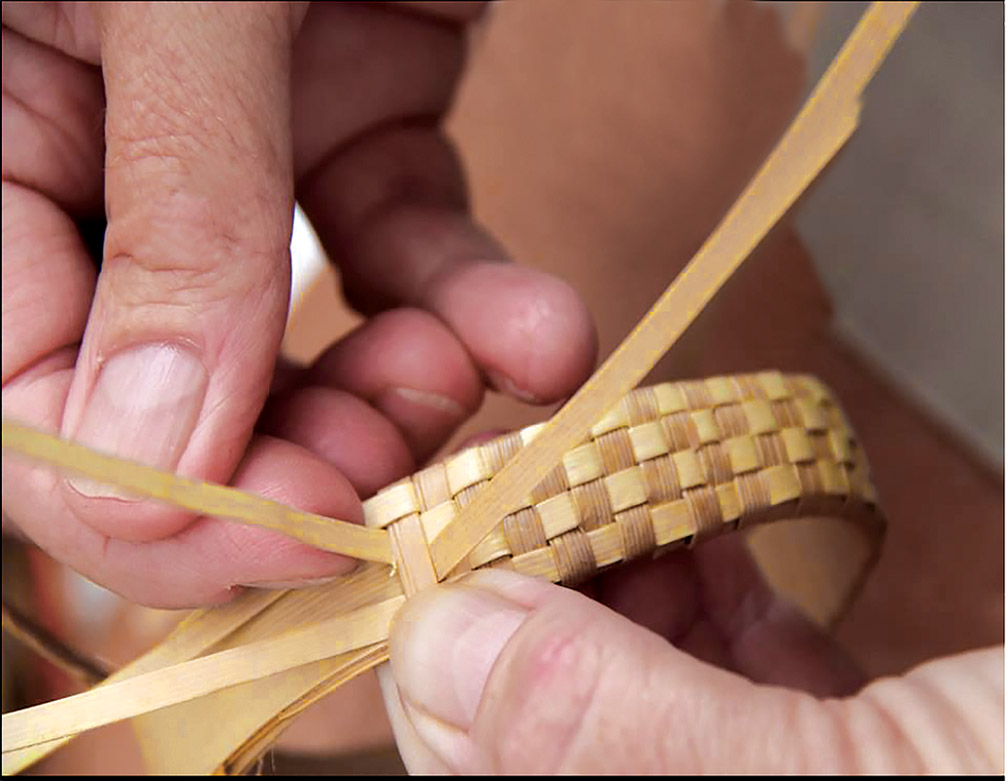Almanac in the Sky
Like many peoples around the world, from ancient times Polynesians have been guided by the stars. The constellations move in predictable rhythms across the sky, with mathematical precision, unchanging over the course of many human lifespans.
Weather patterns come and go, animals nest and fly, plants bloom and fruit, days lengthen and shorten. All these can be predicted by observing the movements of the stars, sun, and moon as if they are a great celestial almanac.
In the 1800s, Hawaiian people still retained the skill of observing the motions of stars, planets, and moon so accurately that “they judged the hours of the night quite as correctly as they did the hour of the day,” according to William Richards, writing in 1841.
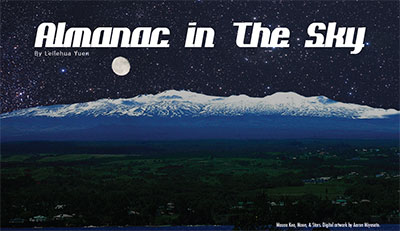 The kilo lani (astronomers/astrologers) of Hawai‘i, had an even more precise and vast knowledge of the heavenly bodies and their workings. They examined the positions of the planets in relation to fixed stars and constellations to predict the success of various activities such as battles and major building projects, as well as the lives and deaths of high chiefs.
The kilo lani (astronomers/astrologers) of Hawai‘i, had an even more precise and vast knowledge of the heavenly bodies and their workings. They examined the positions of the planets in relation to fixed stars and constellations to predict the success of various activities such as battles and major building projects, as well as the lives and deaths of high chiefs.
Time, in the traditional Hawaiian “calendar”, is measured by using both the moon and the fixed stars. According to David Malo, an eminent scholar of the early 19th century, “the ancients reckoned by nights instead of days…names were given to the different nights to correspond with the phases of the moon.
”Hoku, the night of the full moon, is differentiated from hōkū,star. Poetically, “Mahina o Hoku” is a beautiful way to describe the moon on that night. When the full moon sets before daylight, it is called Hoku Palemo, “Moon that Slips Away. ”When it sets after daylight, it is called Hoku Ili, “Stranded Moon.”
In some traditions, the month begins with the first glimpse of the new-born crescent moon above the western horizon. Being rather empirical in approach, practitioners using the celestial “Hawaiian almanac” often adjust the name of the night to match the observed phase of the moon, though others name the days in order and then drop a day or two every few months.
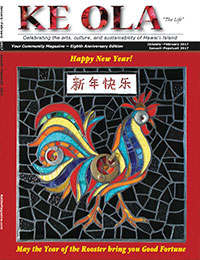
In the tradition documented by Fornander, each month had 30 days, and there were twelve lunar months per year. This left the lunar and solar calendars out of synch by about five days, which was compensated for by making an adjustment at Makahiki time.
Today, it can be confusing to reconstruct many of the ancient modes of codifying knowledge. Different islands, and even different districts on the same island, might have different names for the stars, constellations, and months. Sometimes different practitioners in one district might use different names for the same phenomena.
Messier 45, The Seven Sisters, and the Pleiades all are used in the English language in reference to the same star cluster. Remembering that, it is not strange that Hawaiian people might use Na-Huihui-o-Makali‘i (The Cluster of Makali‘i), Huihui-koko-a-Makali‘i-kau-i-luna (Makali‘i’s rainbow colored nets hung above), Na Wahine-o-Makali‘i (The wife of Makali‘i), Na-ka-o-Makali‘i (The bailers of Makali‘i), or Na-koko-a-Makali‘I (The nets of Makali‘i). The different names serve different purposes, encoding information such as how high above the horizon the cluster is. To a seafarer, this information, combined with other signs, is important in navigation. For the farmer, it is important in determining times to plant, harvest, prepare irrigation, and plan other activities.
People came to the Hawaiian Islands in successive migrations, each bringing their own varients of traditions and once settled, evolved those traditions to suit their new home.
These traditions were codified in oli (chants), mele (songs), and hula (dances). Many have been preserved in hālau hula (schools of traditional dance), in books, and in recordings. Some have remained in continuous use, and some are being studied and brought back into use. Among these is He Ua Lā,He Ua, a portion of which is below. (For another perspective, an excellent piece on it, written by Kīhei de Silva, is posted online. The link is in the bibliography of this article.)
Because of the importance of the Makahiki, the religious/agricultural/political festival marking the change of the Hawaiian year, it was critical to understand the signs marking its advent. Different islands each had their own specifics, but in general a combination of stellar and lunar observations would be used to determine the beginning of the season. People today generally believe that on Moku Hawai‘i, the first Hilo moon (first sighting of the new crescent moon) after the November 17 rising of the Pleiades begins the Makahiki season.
According to Kīhei de Silva’s article on the mele, one tradition for it holds that it was performed for Captain Cook as part of the greeting ceremonies at Kealakekua, which certainly places at least that performance during the Makahiki.
In another tradition, it is believed that this mele lists the months of Makahiki and some of their signs, a belief that is congruent with it being performed at the time of Makahiki for Cook.
| He ua la, he ua He ua pi‘i mai Noenoe hālau Hālau loa o Lono O Lono ‘oe Pā ‘A‘ā na pali I ka hana a ‘Ikuā Pohā kō‘ele‘ele A Welehu ka Mālama Noho i Makali‘i Li‘ili‘i ka hana Aia a e ‘Eu, He ‘eu ia no ka la hiki |
The rain, the rain The rain comes, ascending the slopes An impenetrable mist The great work shed of Lono Thou art Lono ‘A‘ā (Sirius) touches the cliff In the time of ‘Ikuā Storm breaks forth Mālama (unknown star) is in the month Welehu Makali‘i tarries There is little warmth There is ‘Eu (unknown star) ‘Eu that is rising |
Based on the above interpretation of this mele, the almanac in the sky tells us that when ‘A‘ā, Sirius, touches a point on a specific pali (cliff/slope) during the month of ‘Ikuā it is the start of the Makahiki. Depending on the tradition one learns, Hawaiian months run either from Muku (the night of the new moon) to Mauli, or from Hilo to Muku.
Setting Stellarium (a wonderful desktop planetarium program) to January 18, 1779, when Capt. James Cook arrived in Kealakekua, we find at nightfall it is the night of Muku. There is no moon, only stars glimmer above the western horizon. Looking east, we find at full dark that ‘A‘ā burns bright and clear as it rises to touch the limb of the pali.
So, if our celestial almanac began with the Hilo moon of ‘Ikuā, November 22, 1778, then sighting the Hilo moon of December20 began the month of Welehu. At last Makali‘i came, the last month of the Makahiki season and among the coldest of months.
On the last day of Welehu, at the beginning of Makali‘i, Cook arrived with the rising of the hōkū hele, traveling star, ‘Eu. If we run Stellarium, we see that at the time of Cook’s arrival, there is, indeed, a traveling “star”, Jupiter, rising through the fixed stars that designate Makahiki.
Today, we do not know to which star the name ‘Eucor responds. However, we do know that the hōkū hele, the traveling “stars”, the planets, were given many different names. These various names correspond to where and when the planets appear in the sky, and may also relate to other behavior, such as retrograde motion and opposition to the sun. Among its other meanings, ‘eu is the hoot of an owl warning of danger.
Mercury is Ukaliali‘i, a reference to one who attends on a chief. As Mercury’s proximity to the sun assures that it can appear only in the morning or evening sky, never in the middle of the night, with its eccentric orbit it appears to hurry about, coming and going in attendance on Venus, its chief.
Venus, seen in the morning, is called Hōkūao (dawn star or day star). Other names given Venus when seen in the morning are Mananalo or Mānalo (appeased or safe from harm or danger). In the evening, Venus is called Nāholoholo (to flee), or Ka‘āwela (having the nature of heat). Hōkūloa “long [staying] star,” may be the name for Venus after sunrise. It is the third brightest celestial object after the Sun and Moon, and can sometimes be seen long after dawn.
Hōkū‘ula probably references the red color of Mars. ‘Aukelenuiaiku (‘Aukele), another name for Mars, is the name of a hero who sought the water of life. Holoholopīna‘au, may refer to the eccentric orbit of Mars, as holoholo connotes traveling about aimlessly.
Jupiter is known as Aohōkū (star light), ‘Iao, ‘Ikaika (strong or potent), Ikiiki (heat, humidity, pain, suffering), and Kaluaihaimohai. Attempts to translate that last name find a number of words associated with warfare and sacrifice. ‘Iao is a name for Jupiter as the morning star. Also as the morning star, Jupiter shares the name Mānalo with Venus. As the evening star, Jupiter shares with Venus the name Ka‘āwela . Many of the names for Jupiter are associated with wela (heat), war, and sacrifice. Perhaps this is related to the unknown star known as ‘Eu.
Saturn is known as Makulu or Mākulukulu, “Dripping.” With the clearer skies of ancient Hawai‘i, and trained eyesight of the kilo lani and kilo hōkū, could our ancestors actually see the changing shape of Saturn? Could the dripping refer to its changing shape? Some say yes, and some say no. But they certainly would have seen the waxing and waning light of this golden planet, which might have inspired the name.
Hōkū (stars), were certainly recognized from ancient times as having different characteristics from planets—hōkū‘ae‘a (shiftless, wandering, unstable, vagrant), hōkūhele (going, coming, moving), and hōkūlewa (floating, dangling, oscillating). With the exquisite attention to detail traditional Polynesians, including Hawaiians, exercised, one wonders if the different names for planets designated the differing orbital motions.
There are many websites with information on the names of the months and days, including Ka‘ahele Hawai‘i (kaahelehawaii.com/nana-i-na-hoku-star-lore-of-hawaii). Those interested in further study can find numerous resources.
With increasing light pollution, it is more and more difficult for the average person to directly study the stars. Computer programs such as Stellarium can help in understanding the skies our ancestors saw, but there is no substitute for going outside and raising one’s face to the night sky.
Much of the lore regarding the Hawaiian “Almanac in the Sky” has been lost, but as the Hawaiian language newspapers are being digitized, a lot of information and hints are being found. Perhaps with greater study, we shall recognize the importance of this knowledge for understanding the people and cultures of ancient times, and therefore the roots from which we have grown. Also, perhaps it will teach us to value the dark night sky which does not hide, but reveals the stars and planets in all their glory.
Contact writer Leilehua Yuen: kumuleimanu@gmail.com
